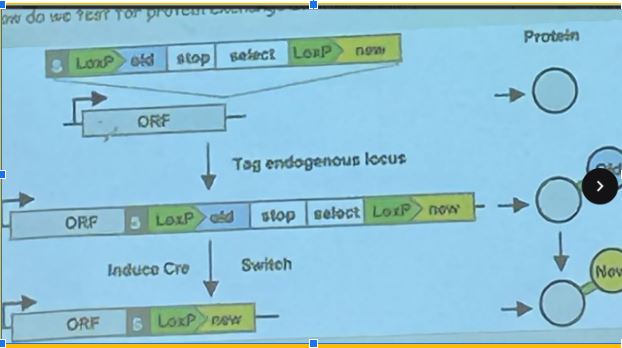Nucleus Part 2
1/35
There's no tags or description
Looks like no tags are added yet.
Name | Mastery | Learn | Test | Matching | Spaced |
|---|
No study sessions yet.
36 Terms
What is confocal laser microscopy?
You use small beams of light with short wavelengths to hit multiple spots on a single layer to make an image. You use multiple layers at different times and stack them to form a 3D image. We do this by making the aperture very small
Why don’t we use larger wavelengths and beams of light as well as shining light on multiple layers at a time in CLSM?
Because this decreases resolution and makes the image blurry
How can you use CLSM and immunofluorescent antibodies together?
You use CLSM to visualize the flourescence, you use one antibody directly for the antigen of interest and then a second antibody with a fluorescent marker that emits light when it binds to the first antibody
Why use super resolution CLSM?
The is a resolution limit because the wavelength of light can only be so small, this technique gets around that
What is super resolution CLSM?
Filters the laser through a filter that makes the light appear in a grid like pattern and is layered across the other layers and increases the resolution of the image making it 10x better
What is STED?
uses multiple filters and lasers so that the molecules within the rings of a filter are excited at different colors, this allows you to see different structures emitting different light so you can differentiate
What is Lattice light-sheet fluorescence microscopy?
can be combined with multiple fluorescent tagged protein markers so you can see the complexity of organelle-organelle interaction is real time
What is TEM?
Shows inner structures in thin layers
When is it easiest to make/introduce a nuclear pore complex to the membrane?
After nuclear membrane rupture in mitosis
How does NPC synthesis start? When?
before membrane assembly and starts at the inner membrane then goes outwards
Why is protein turn over time in the nucleus so long?
synthesis is hard in the nucleus
Describe NPC structure?
Spans two membranes, has a basket at the inner membrane side with RNA-GTP, facilitates mRNA export, NUPs act as scaffold or TANO proteins, GTPase at other side of the membrane
During what phases does the NPC assemble?
Late open mitosis and during interphase
How are defective NPCs related to disease?
can prevent protein import/export and accumulation of proteins may cause infertility or alzheimers
How do NUPs get into the membrane when it is formed?
The are made in the ER and are diffused along the membrane to desired site where they bind chromatin and lamina
How are soluble proteins transported into the nucleus?
Through NPCs
What technique do we use to see nuclear membrane proteins? (FRAP)
use FRAP, we expect the proteins to be motile so we use GFP tagged proteins and bleach an area of interest (no green light) then watch as the GFP tagged proteins migrate into the area

How does NPC assembly during interphase work?
FG complexes (FG NUPs) are self assembling and are sequestered in a lipid pore before being deposited in the NPC, two proteins will be made in the cytoplasm A and B, they have hydrophobic binding domains and binding signal domains, they are made in sections so that A and B bind through recognition domains first and then their hydrophobic domains when inside the NPC
How are misfolded proteins in the NPC regulated?
A membrane will form around them to trap them, may also be degraded by a proteasome
What happens when an NPC starts to leak or clog at the top vs the bottom?
clogging at top leads to autophagy (degradation of organelle), bottom leads to ESCRT mediated sealing

How do we test for protein exchange at NPC?
clone the proteins gene of interest into a cell along with a tag called LoxP on each side, the gene will have flanking LoxPs, the old coding region, a stop codon and a selectable marker, the stop codon lets us express the old protein, we then use Cre to splice the gene and we can now get expression of the new protein with the tag and can visualize it being replaced
When are NUP proteins exchanged?
When a NUP is defective
Where a defective NUPs found normally?
In one location in the cell usually clustered
What is the ERAD pathway?
ER associated degradation, uses proteasome to degrade proteins tagged with ubiquitin, proteins go through cycle to get folder properly, long in pathway more chance of degradation
What happens with defective NPCs?
ESCRT proteins can reseal the immature pores and pump them full of ubiquitin
What is a way that nuclear envelope architecture can be altered? (squeezing)
When structures that tie chromosomes to cytoskeletal elements in the cytoplasm are affected, they can squeeze the nucleus, causing it to be malformed,
Where would you find more stiff and squishy cell structures?
Stiff in the muscles, squishy would be white blood cells and cancer cells
What proteins influence stiffness?
More lamina A in the nucleus causes stiffness, lamina B is opposite
What is an important nuclear lamina protein
What do Sun proteins do? What is this also called?
They link the cytoskeleton to the lamina, the link complex
What happens when SUM complexes are squeezed?
They cluster together and lead to high pressure areas causign a confirmational change, there are then phosphorylases present
What is the consequence of high pressure points and phosphorylases on the SUM complex?
phosphorylates emerin and it then binds tightly to the SUM complex and lamin A causing stiffness
What are the consequences of nuclear rupture?
nucleases in cytoplasm enter and damage DNA, big ruptures can lead to organelle entry that makes products that damage DNA
What can happen as a result of lamina A deficiency?
Cancer
What can cause a rupture?
Squeezing in an out of pores and tight spaces, happens frequently in white blood cells and cancer (this causes further DNA mutations due to damage)
What happens when DNA/chromsomes bud out during nuclear rupture?
ESCRT will repair the tear and leave behind a scar before the membrane can pop